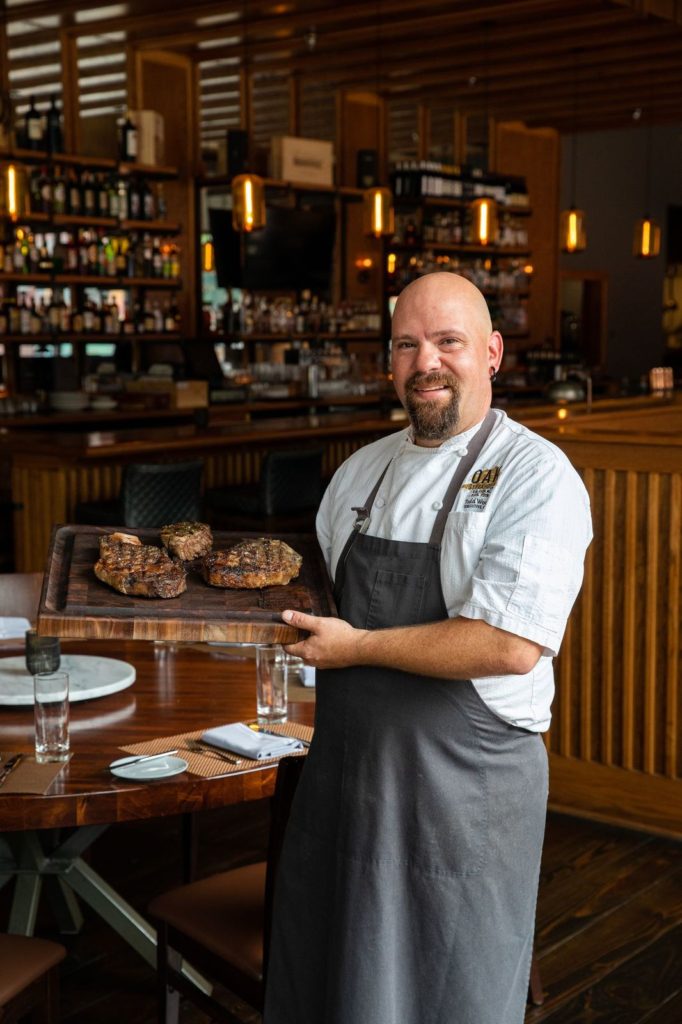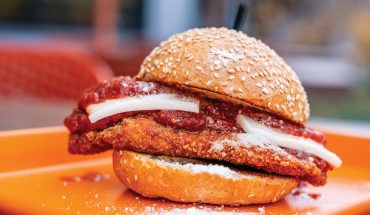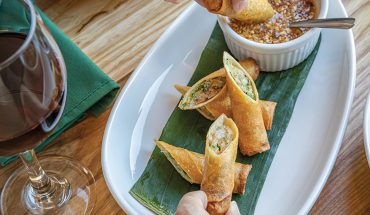The executive chef at Raleigh’s Oak Steakhouse shares tips and tricks for a sizzlin’ summer cookout.
by Emma Ginsberg
When it comes to midsummer dinner parties, the magic of a cookout is unrivaled. Warm weather, twinkling fireflies and the vibrant colors of twilight combine with a quintessential smell of summer: freshly grilled steak. Grilling can be intimidating for beginners — and hard to master, even for longtime grillers — so consider these 10 tips from chef Todd Woods from Raleigh’s Oak Steakhouse to get steak on the grill right, every time.
Choose prime
Prime is the USDA’s highest measure of beef quality, and cuts of this grade usually have more marbling than choice or select beef. If you can, look for Certified Angus Beef (CAB). Chef Woods’ favorite prime cut is ribeye, as the marbled fat softens when cooked to imbue the steak with tenderness and flavor. Prime beef will be labeled at your local grocery store, but if you’re having trouble identifying it, the butcher can help you out.
Bring meat to room temperature
A thawed steak will cook more evenly than a frozen one, but even a refrigerated steak will cook better if you don’t start too cold, so let your meat come to room temperature before you grill it. Set it out for at least 15 minutes before grilling, but never for more than an hour on hot days.
Coat with butter
Slather the meat with butter or olive oil to keep it flavorful and moist. Woods prefers butter, but if you’re using olive oil, make sure it’s not extra virgin olive oil, which tends to get bitter and acrid at high temperatures.
Season aggressively
A nice salty crush helps with the steak’s flavor. Woods likes Diamond Crystal Kosher Salt because it has smaller flakes, and he finds that it adheres to the meat better than Morton’s Kosher Salt. The thicker the cut, the more salt you’ll need. If your steak looks frosted on the outside, you’re doing it right!
Start hot
When you put your steak on the grill, start out on high heat and the hottest part of the grill to get that beautiful, dark sear. As the steak cooks, work your way to low heat and the cooler end of the grill so that the inside of the cut stays moist.
Flip 3 times
Most folks flip their steaks twice, but Woods finds that if you flip your steak over three times throughout the grilling process, it offers more even cooking and gives it that Instagram-worthy crosshatch.
Consider a cake tester
Woods likes to use a metal cake tester to test his steak’s temperature instead of a meat thermometer. Cake testers are usually smaller than meat thermometers, and don’t leave big holes for juices to escape through. To do: insert the cake tester into your meat, then remove it and touch the metal to the bottom of your lip. The tester will feel cold for rare meat, cool but not cold for medium rare, slightly warm for medium, and hot for medium well. Well done steak will be too hot to touch, so use a thermometer for that one! Chef Woods recommends cooking well done meat to 165 degrees.
Let the steak rest
After you’ve taken your steak off the grill, allow the meat to rest for about half the time it took to cook. Moisture pushed towards the center of the steak during cooking needs time to reabsorb into the meat fibers so that all those good juices don’t spill out when you cut into the steak.
Slice across the grain
Woods says to always your meat across the grain instead of with the grain. Slicing perpendicular to the direction your meat fibers run, instead of parallel to it, will yield a much more tender cut that’s easier to chew.
Finish the steak
Woods likes to finish his steaks with herb butter and flaky Maldon sea salt for a blast of flavor.
P.S. Need some sides to accompany that steak?
Add them to the grill, too! “Anything that gets kissed by the grill is better! Not just steaks,” says Woods. “Vegetables, poultry, and fish are some of my favorite things to put on the grill.” Consider these ideas for some great vegetables to throw on the grill.





